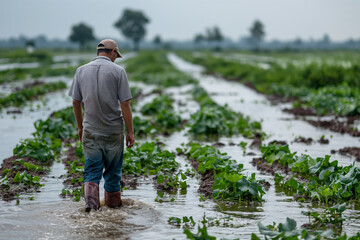Heavy rain can pose significant challenges for farmers, affecting crop yields, soil health, and overall farm productivity. However, with proper preparation and management strategies, farmers can mitigate the negative impacts of excessive rainfall. Here are some practical tips to help farmers handle heavy rain and protect their crops and livestock.
1. Implement Proper Drainage Systems
One of the most critical steps in managing heavy rain is ensuring that your farm has an efficient drainage system. Proper drainage helps prevent water from pooling in fields, which can lead to waterlogging, root rot, and other plant diseases. Farmers can use techniques such as:
- Installing Drainage Ditches: These are channels dug along fields to direct excess water away from crops.
- Using Raised Beds: Raised beds can improve water drainage and soil aeration, making them ideal for areas prone to heavy rain.
- Installing Subsurface Drainage (Tile Drainage): This involves placing pipes beneath the soil surface to collect and transport excess water away from fields.
By implementing these drainage solutions, farmers can reduce the risk of water-related crop damage.
2. Choose Flood-Resistant Crops
Certain crops are more tolerant of wet conditions than others. When heavy rain is expected, consider planting flood-resistant varieties that can withstand waterlogged soils. Crops such as rice, sugarcane, and some types of vegetables (e.g., kale and spinach) are known for their ability to thrive in wetter conditions. Additionally, selecting early-maturing crop varieties can help avoid the peak rainy season, reducing the risk of crop damage.
3. Practice Soil Conservation
Heavy rain can cause soil erosion, which depletes the soil’s fertility and structure. To protect the soil, farmers should implement soil conservation practices such as:
- Cover Cropping: Planting cover crops like clover, rye, or alfalfa helps protect the soil from erosion and improves soil health by adding organic matter.
- Contour Plowing: This technique involves plowing along the contours of a slope, which helps reduce runoff and soil erosion.
- Mulching: Applying mulch around crops can help retain soil moisture, prevent weed growth, and protect the soil from heavy rain impact.
By maintaining healthy soil, farmers can enhance their crops’ resilience to heavy rain and other environmental stressors.
4. Maintain Proper Water Management
While heavy rain can provide abundant water, it’s essential to manage this resource effectively. Farmers should monitor soil moisture levels and avoid over-irrigating, which can exacerbate waterlogging issues. Additionally, creating water retention areas such as ponds or reservoirs can help capture excess rainwater for use during dry periods. These water management strategies can improve water efficiency and reduce the risk of crop damage.
5. Use Proper Livestock Management Practices
Heavy rain can also impact livestock, leading to health issues and discomfort. To protect animals, farmers should:
- Provide Adequate Shelter: Ensure that livestock have access to dry, sheltered areas during heavy rain to prevent exposure-related health issues.
- Monitor Feed and Water Supplies: Wet conditions can affect feed quality and water sources. Farmers should regularly check and maintain these resources to ensure they remain clean and safe for livestock consumption.
- Manage Grazing Areas: Avoid grazing animals on waterlogged pastures, as this can lead to soil compaction and damage to pasture vegetation.
By taking these precautions, farmers can safeguard their livestock’s health and well-being during periods of heavy rain.
6. Prepare for Emergencies
Heavy rain can sometimes lead to flooding and other emergencies. Farmers should have an emergency plan in place to protect their property, crops, and livestock. This plan should include:
- Evacuation Routes and Procedures: Clearly defined routes and procedures for evacuating livestock and staff in case of severe flooding.
- Emergency Supplies: Stocking up on essential supplies such as feed, water, and medical supplies for both animals and humans.
- Communication Plan: Establish a communication plan with family, employees, and local authorities to stay informed about weather conditions and emergency alerts.
Being prepared for emergencies can help farmers respond quickly and effectively to unexpected situations.
7. Stay Informed and Adapt
Finally, staying informed about weather forecasts and climate trends is crucial for managing heavy rain. Farmers should regularly check local weather updates and be aware of seasonal weather patterns. Additionally, participating in agricultural extension programs and workshops can provide valuable information on best practices for managing heavy rain and other challenges.
Adaptability is also key. As climate change continues to affect weather patterns, farmers may need to adjust their farming practices and crop choices to suit changing conditions. Being flexible and willing to adapt can help farmers stay resilient in the face of heavy rain and other environmental challenges.
If you wat to know about summer farming Click Here..
Conclusion
Heavy rain can present significant challenges for farmers, but with the right strategies, these challenges can be effectively managed. Implementing proper drainage systems, choosing flood-resistant crops, practicing soil conservation, and preparing for emergencies are all essential steps in protecting crops and livestock from the adverse effects of heavy rain. By staying informed and adaptable, farmers can continue to thrive even in the face of unpredictable weather patterns.



